Tabby cats, with their distinctive stripes, swirls, and spots, are a beloved sight in homes around the world. The term “tabby,” however, often leads to confusion. It’s not a breed, but rather a coat pattern – a beautiful tapestry woven across the fur of countless domestic and wild felines. While their striking markings might be what first catches your eye, prospective and current tabby cat owners often wonder about a more fundamental aspect of sharing their lives with these animals: their lifespan. Understanding the Tabby Cat Lifespan isn’t just about numbers; it’s about preparing for years of companionship and ensuring your striped friend lives a long, healthy, and fulfilling life by your side.
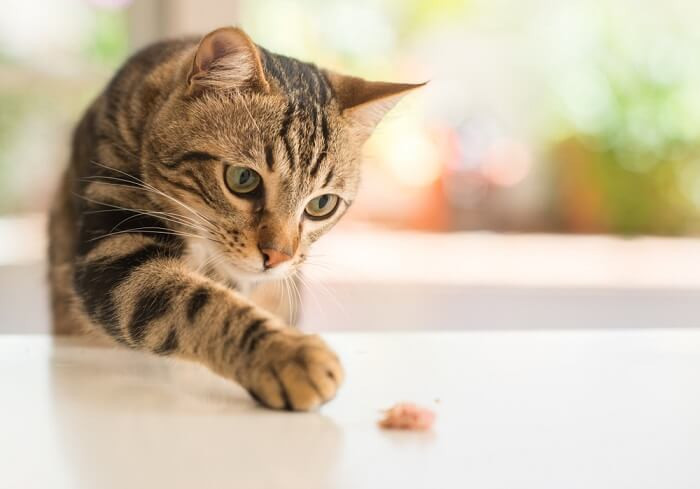 A close-up shot of a tabby cat's face, showcasing the distinctive 'M' marking on the forehead.
A close-up shot of a tabby cat's face, showcasing the distinctive 'M' marking on the forehead.
What Defines a Tabby Cat? More Than Just Stripes
Before delving into lifespan, it’s important to clarify what makes a cat a tabby. The tabby pattern is a naturally occurring coat marking found in domestic cats and their wild ancestors. Think of it as a basic feline coat template, expressed through various patterns. These patterns aren’t limited to specific breeds; you can find tabbies in breeds as diverse as Maine Coons, Persians, and even Siamese mixes. The common thread is the presence of the agouti gene, which dictates the banded hairs that create the tabby’s signature look.
Tabby cats are characterized by more than just their patterns. Many share common features, such as a distinctive “M” marking on their forehead, dark eyeliner-like markings around their eyes, and pigmented paw pads and lips. These traits, combined with their varied coat patterns, contribute to the unique charm of every tabby cat.
Decoding the Tabby Coat: Five Classic Patterns
Every tabby cat boasts a unique coat, but these patterns generally fall into five recognized categories:
- Classic Tabby: Characterized by bold, swirling patterns, often described as a “target” or “blotched” pattern on their sides. American Shorthairs are frequently seen with this pattern.
- Mackerel Tabby: The most common pattern, featuring stripes that run parallel down the body, resembling a fish skeleton – hence the name “mackerel.” Often called “tiger cats” due to their striped appearance.
- Spotted Tabby: As the name suggests, these tabbies have spots of varying sizes across their body, which can sometimes appear as broken mackerel stripes. Ocicats and American Bobtails are known for their spotted coats.
- Ticked Tabby: Also known as Abyssinian tabby or agouti tabby, this pattern lacks distinct stripes or spots on the body, except possibly on the legs and tail. The coat has a “salt-and-pepper” appearance due to agouti hairs with multiple bands of color.
- Patched Tabby: This isn’t a pattern type itself, but rather a description of tabbies with additional colors or patterns. Calico or tortoiseshell cats with tabby markings are considered patched tabbies, with “torbie” being the term for tortoiseshell tabbies. Orange tabbies, displaying any of the above patterns in orange and white, also fall under this broader category.
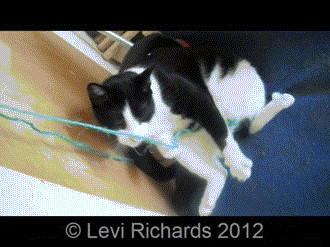 A collage showing the five tabby cat patterns: Classic, Mackerel, Spotted, Ticked, and Patched.
A collage showing the five tabby cat patterns: Classic, Mackerel, Spotted, Ticked, and Patched.
The Genetics Behind the Stripes: Tracing the Tabby Gene
The tabby pattern is deeply rooted in feline genetics. All domestic cats carry the tabby gene, a legacy inherited from their wildcat ancestors. This ancestral connection includes the African wildcat, European wildcat, and Asiatic wildcat – all known for their tabby markings.
Whether a cat visibly displays the tabby pattern depends on the interplay of genes, specifically the agouti gene. A dominant agouti gene (A) allows the tabby pattern to be expressed, while a recessive non-agouti gene (a) can mask it, resulting in a solid-colored coat. However, even solid-colored cats with two copies of the recessive non-agouti gene (aa) might exhibit “ghost striping,” subtle tabby markings visible in bright light, hinting at their underlying tabby genetics.
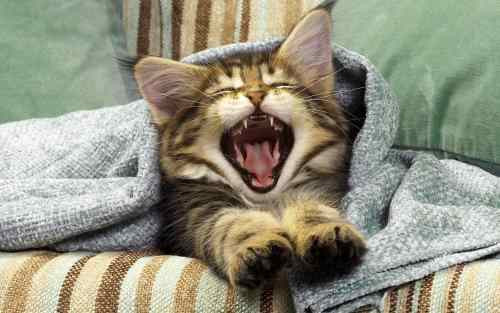 A ginger tabby cat lying comfortably, showcasing the typical tabby markings on its coat.
A ginger tabby cat lying comfortably, showcasing the typical tabby markings on its coat.
Tabby Cat Appearance: Beyond the Pattern
While the coat pattern is the defining feature, tabby cats share other common physical characteristics. These often include:
- The distinctive “M” marking on the forehead.
- Dark “eyeliner” outlining their eyes.
- Pigmented lips and paw pads.
- Fine “pencil lines” on their face.
- A lighter chin and belly compared to the rest of their body.
- Banding patterns on their legs and tail.
These features, alongside the various tabby patterns, contribute to the diverse yet recognizable appearance of tabby cats.
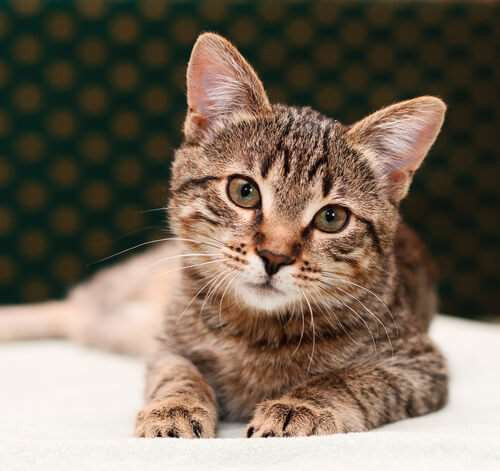 A tabby cat with green eyes looking directly at the camera, highlighting the facial markings.
A tabby cat with green eyes looking directly at the camera, highlighting the facial markings.
Tabby Cat Personality: Is There a “Tabby” Temperament?
Due to the wide range of breeds that can exhibit the tabby pattern, generalizing about tabby cat personality is challenging. Temperament is more closely linked to breed and individual genetics than coat pattern. However, anecdotal evidence from tabby cat owners suggests some common personality traits. Many describe their tabby companions as friendly, affectionate, and playful.
To get a better understanding of a specific tabby cat’s personality, considering their breed is helpful. Breeds like Abyssinians are known for their activity and intelligence, while American Bobtails are often playful and family-oriented. Scottish Folds are known for their sweet and adaptable nature. Mixed-breed tabbies will have a personality influenced by their diverse genetic makeup. DNA tests, like the Basepaws kit, can help unravel your cat’s breed ancestry and provide insights into potential personality traits associated with those breeds. Ultimately, individual personality will vary, and spending quality time with your tabby is the best way to understand their unique temperament.
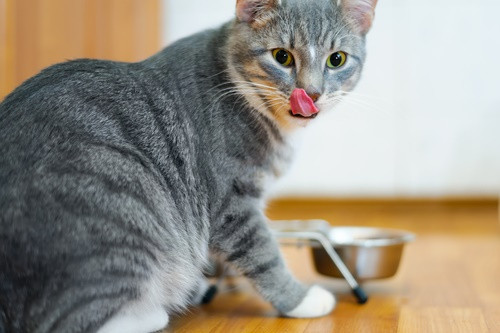 A person petting a tabby cat, illustrating the affectionate nature often associated with tabbies.
A person petting a tabby cat, illustrating the affectionate nature often associated with tabbies.
Tabby Cat Lifespan: What to Expect and How to Maximize It
Now, let’s address the key question: What is the average tabby cat lifespan? Generally, tabby cats, like most domestic cats, have a lifespan of 12 to 15 years. However, many factors can influence this range, and with proper care, some tabbies can live even longer, reaching 18 to 20 years or beyond.
Factors Influencing Tabby Cat Lifespan
Several factors play a crucial role in determining how long your tabby cat will live:
- Indoor vs. Outdoor Lifestyle: Indoor cats consistently live longer than outdoor cats. Outdoor cats face risks like traffic accidents, predators, diseases, and exposure to harsh weather, significantly reducing their lifespan. Indoor tabbies, protected from these dangers, have a higher chance of living a full and long life.
- Diet and Nutrition: A high-quality, balanced diet is fundamental to a cat’s health and longevity. Providing age-appropriate cat food that meets their nutritional needs supports their immune system, maintains a healthy weight, and prevents diet-related health issues.
- Veterinary Care: Regular veterinary check-ups are essential for preventative care and early disease detection. Vaccinations, parasite control, dental care, and prompt treatment of illnesses contribute significantly to a longer and healthier life for your tabby.
- Genetics and Breed: While “tabby” isn’t a breed, certain breeds known for tabby patterns may have predispositions to certain health conditions that could impact lifespan. However, for mixed-breed tabbies, genetics can be diverse, and responsible breeding practices can minimize hereditary health issues.
- Environment and Care: A safe, stimulating, and loving home environment contributes to a cat’s overall well-being and lifespan. Providing fresh water, a clean litter box, scratching posts, toys, and plenty of attention helps keep your tabby cat happy and healthy.
Maximizing Your Tabby Cat’s Lifespan
You can actively contribute to extending your tabby cat’s lifespan by following these guidelines:
- Keep Your Tabby Indoors: This single step dramatically reduces risks and increases their life expectancy.
- Feed a High-Quality Diet: Choose age-appropriate, nutritionally complete cat food and avoid overfeeding.
- Schedule Regular Vet Visits: Annual check-ups, vaccinations, and dental care are crucial.
- Provide Plenty of Fresh Water: Ensure fresh water is always available to prevent dehydration and urinary issues.
- Create a Safe and Enriching Environment: Offer toys, scratching posts, climbing structures, and interactive playtime to keep them physically and mentally stimulated.
- Show Love and Affection: A loving and stress-free environment contributes to their overall well-being.
By prioritizing these aspects of care, you can significantly improve your tabby cat’s chances of enjoying a long and happy life by your side.
Fun Facts About Tabby Cats: More Than Just a Pattern
Tabby cats are full of fascinating facts, adding to their already endearing nature:
- Orange tabby cats are often nicknamed “marmalade cats.”
- The word “tabby” might originate from “Attabiy,” a district in Baghdad known for patterned silk.
- Striped tabby cats are often called “tiger cats” due to their resemblance to tigers.
- Legend says a tabby cat helped keep baby Jesus warm, and Mary marked its forehead with an “M” in gratitude.
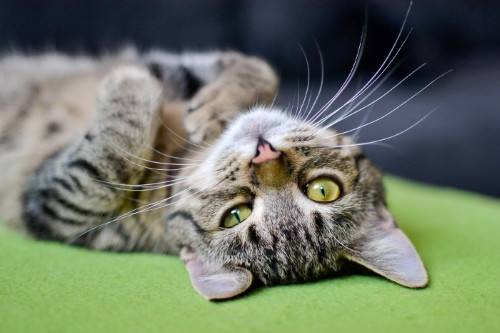 A playful orange tabby cat with bright green eyes, showcasing the marmalade coloration.
A playful orange tabby cat with bright green eyes, showcasing the marmalade coloration.
Conclusion: Cherishing the Years with Your Tabby Companion
The tabby cat lifespan is a significant consideration for any cat lover. While the average lifespan ranges from 12 to 15 years, remember that this is just an average. By understanding the factors that influence longevity and providing optimal care, you can help your tabby cat live a longer, healthier, and happier life. The unique patterns and often affectionate personalities of tabby cats make them wonderful companions. Embrace each moment with your striped friend, knowing that with love and proper care, you can share many wonderful years together.
Frequently Asked Questions about Tabby Cats
Are tabby cats affectionate?
While “tabby” refers to a coat pattern, many owners report their tabby cats are indeed affectionate and friendly. Individual personality varies, but the tabby pattern itself isn’t linked to temperament.
How much does a tabby cat cost?
The cost of a tabby cat depends on factors like breed, age, and source (breeder, rescue, etc.). Mixed-breed tabbies from shelters are usually the most affordable, while purebred tabbies can vary in price.
Do tabby cats shed a lot?
Shedding varies by breed and coat type, not specifically by the tabby pattern. Longhaired tabby breeds might surprisingly shed less than some shorthaired breeds but may require more grooming.
How big do tabby cats grow?
Size varies significantly depending on breed. Maine Coon tabbies are large, while Oriental tabbies are slender and medium-sized. Generally, tabbies reach full size around 13-18 months old.
